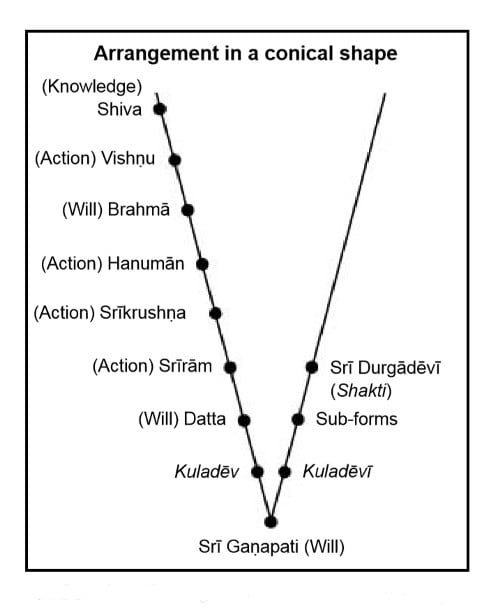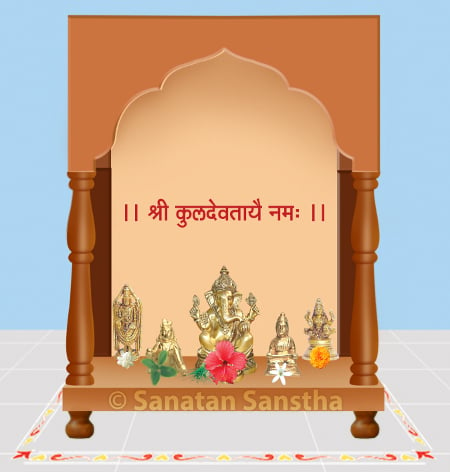A temple at home is the basic requirement for puja. This article gives information on correct way of arranging the Deities in Home temple to derive maximum spiritual benefit of the God Principle.
1. Conical arrangement of Deities in Home temple
Arrange the Deities in a conical shape. In front of the devotee performing the puja at the tip of the cone, that is, at the centre, place Shri Ganesh. To the right of the devotee place the female Deities beginning with the family Deity followed by sub-forms of superior Deities and then other female Deities. To the left of the devotee place the male Deities in the same sequence as right side. A. The seven superior Deities and their sub-forms
A. The seven superior Deities and their sub-forms
| Deity | Sub forms of Deities |
|---|---|
| 1. Shri Ganapati | – |
| 2. Shriram | – |
| 3. Maruti | Panchamukhi (Five-headed) Maruti (Manifest kriya-shakti) Dasmaruti (Ichha-shakti) Veermaruti (Unmanifest kriya-shakti) |
| 4. Shiva | Vetal (Kriya-shakti) |
| 5. Shakti | Nine forms of Shri Dugadevi |
| 6. Datta | – |
| 7. Shrikrushna | Balkrushna (Ichha-shakti), Balaram (Kriya-shakti) |
B. Sequence of arrangement of superior Deities
Other Deities should be given preference over the superior Deities – Brahma, Vishṇu and Mahesh, which represent Creation, Sustenance and Dissolution respectively. The preference should be in accordance with their association with waves of will, action and knowledge respectively.
2. Characteristics and significance of the conical arrangement
In a conical arrangement of Deities, the tip represents the Shakti that is active by manifesting in sagun form followed by nirgun forms of Shanti (Peace) and Anand. Shri Gaṇesh, followed by the sub-forms of superior Deities and then the superior Deities themselves respectively represent the journey of an individual from the sagun to the nirgun state. Gradual widening of the cone denotes the wider coverage of nirgun.
Shri Ganesh is placed in the centre. He comprehends the human language (of sound), hence, He is the Deity who can be pleased first. Shri Ganesh is a Deity who transforms the language of sound to language of light and vice-versa. Other Deities mostly understand only the language of light. Besides, Shri Ganesh is also associated with waves of desire. That is why, He conveys the desires of the devotee to his Kuladev (Family male Deity) or Kuladevi (Family female Deity) who then rush to his help. The Kuladev or Kuladevi also plead before superior Deities for fulfilment of their devotee’s desires, as a result of which, their Principle is activated and functions for the individual’s benefit.’
3. Spiritual experience – Appropriate arrangement of Deities in the Home temple
Because of the appropriate arrangement of Deities in the Home temple, a woman that was bedridden for 10 years being able to stand on her feet : I went to one household in the village of Kharpatti (in Roha Taluka, District Raigad, Maharashtra). The arrangement of the Deities in the Home temple was not correct. Among the Deities was also a picture of his deceased father. I said to him, “Shyam, because of the inappropriate arrangement of the Deities, (spiritual) distress is perceived in your house. Place in the temple only those Deities which are essential and immerse the rest in flowing water”. Mr. Shyam immediately followed what I had told him. Thereafter, his mother who was bedridden for 10 years was able to stand taking the support of the wall.’ – Mr. Anant Kokabankar, Ghatkopar, Mumbai, Maharashtra.
4. Some practical suggestions
A. What if there are less Deities to be kept in the Home temple ?
For example, if there are sub-forms of Deities and none of the superior Deities, then in the conical arrangement should the photos of superior Deities be placed at all ?
‘There is no need to place new photos. Place the one’s you have as per the arrangement. Shri Ganesh, Kuladevi and Kuladev are sufficient, because this helps the individual awaken bhav faster than for other Deities. This rule is applicable to puja and it is associated to a large extent with the sagun form of Deities. In spiritual practice involving worship of sagun form, going from many to one, that is, going towards nonduality is more important. Our sojourn should be from Idol worship to the various sagun and nirgun Principles of the respective Deities, and from there on to God who, although completely linked with the nirgun, encompasses all these Principles.
B. What if in the Home temple there are many Deities ?
For example, if there are two or more sub-forms of a Deity, should both be retained or only one will do ?
The inclination of the individual should be towards retaining only one of the two forms. Constant awareness of the fact that we have to move from ‘many to one’ at every step and developing faith in God to match this awareness should be our goal. Only then, can a individual traverse from sagun form to the nirgun form of God.
Reference : Sanatan Sanstha’s Holy Text on ‘Temple at home and implements used in the worship of God’


